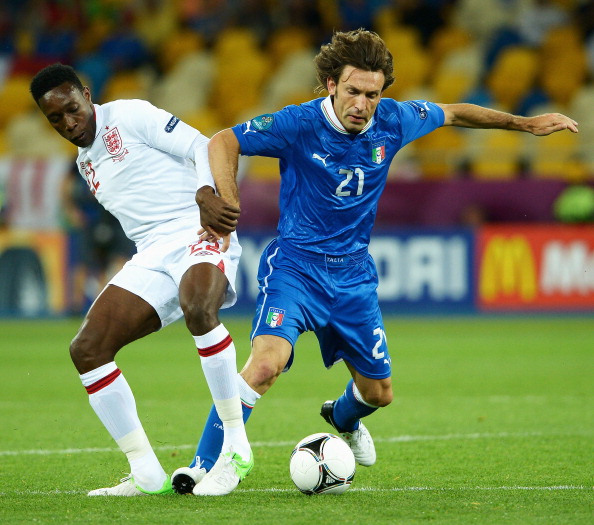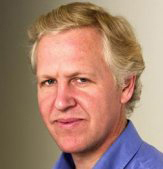Michel Platini once bemoaned to me the extinction of the old-style ‘Number 10’, a position in which he, of course, excelled like few others.
“They have practically done away with le Numéro 10,” he said, sitting in a large office across the street from the Comédie Française.
“There is practically no longer an organiser.
“For 100 years it was the Number 10 who organised the game.”
Six years on and it has become clear what really happened.
The Number 10, the creative fulcrum, is not extinct; he has merely retreated 30 metres back up the pitch towards his own goal.
This has been evident ever since the emergence of Xavi’s Spain, the current world and European champions.

But it was never more evident than in the virtuoso display conjured up on Sunday (June 24) night in Kiev by Italy’s Andrea Pirlo (pictured above, right), in the match that ended England’s latest attempts to assuage 46 years (and counting) of hurt since their sole major tournament victory in 1966.
Pirlo controlled the match as surely as Platini controlled the entire 1984 European Championship.
But he operated for much of the time – like Xavi (pictured below) and, to an extent, Germany’s Bastian Schweinsteiger – from a pocket in front of his own back line.
Understanding why this has happened is one of the keys to understanding the modern game.
The explanation, in a word, is “space”, a commodity which has never been in such short supply on the football pitch as it is at present and which, consequently, has never been more precious.
As Platini also said when I asked him the main difference between football when he was playing and as it is played today, “On court plus”, “Players run more”.
This means, as night follows day, that the Number 10s of 2012 can rarely find the time to exercise their art close to the opposition’s goal.
So they have retreated.
Because the ball can travel faster than the man, it is still possible to pull your team’s creative strings from this range.

But it requires patience, the technique to stroke a 50-metre pass with absolute accuracy and, rarest of all, the eye to spot the optimum moment to execute such a pass.
Launch an attack while the massed ranks of today’s supremely fit, superbly well-drilled “two-banks-of-four” defences are correctly positioned and the odds are stacked against you.
And if your team pushes up too abruptly in injudicious numbers, you are liable to gift the opposition an abundance of the space that is key to effective counterattacking.
So the best teams have learnt to bide their time, awaiting the instant when their forward runners have pulled those massed defences momentarily out of shape, improving the odds of engineering a successful strike on goal without over-committing.
This explains the modern emphasis on possession and why the vast majority of passes executed by Xavi, Pirlo and their ilk are of the simple five-metre variety.
If, on seeing Xavi play, you find yourself thinking, like a tourist confronted by a Rothko painting, “I could have done that”, you are missing the point.
Time spent in possession of the ball, moreover, is time not spent in the exhausting business of retrieving it.
If Spain have won a reputation, along with everything else, as an effective pressing team, it is in part because they are required to demonstrate those skills far less frequently than their opponents.
Of course, matches pitting two skilled and disciplined exponents of this patient approach against each other do tend to lack goalmouth incident.
This is why I particularly enjoy watching the new Germany.

Under coach Joachim Löw’s guidance, they seem to have absorbed what they can from Spain and Barcelona while retaining enough flexibility to exploit the strength and athleticism of the likes of Thomas Müller and Lukas Podolski (pictured above, right).
Perhaps something like this is the way ahead for Roy Hodgson’s solid but one-dimensional England.
It is a worry, though, how many of the more gifted England youngsters appear to be acquiring a skill-set serving only to equip them for a peripheral role in a Spanish- or German-type system.
The aerial power, speed and panache of, respectively, Andy Carroll, Theo Walcott and Alex Oxlade-Chamberlain are potentially devastating against weaker sides, or when England – or their opponents – are chasing the game.
It is much harder to see how they would fit into a winning strategy in a tournament match against a top-five European opponent.
If England today look much further from a team capable of winning a major tournament than their counterparts a decade ago, it is in part because, with the benefit of hindsight, the 2002 World Cup and Euro 2004 were sub-standard.
But those responsible for the English coaching system also need to think seriously about the way young players are formed.
The England team of that period, after all, included a player whose right foot was of the very highest class, although he lacked pace and was not the greatest tackler.

I wonder whether, if David Beckham (pictured above) had come up through the Italian or Spanish youth coaching set-up, they would have been content to develop him as a wide-right ‘corridor’ player.
Or would they instead have worked on his left foot and his vision and brought him inside to be a bona fide playmaker (and link up with one Paul Scholes)?
It’s an academic question, of course, but the sort of thing it is worth pondering if England is ever again to make the most of the very considerable talent at its disposal.
David Owen worked for 20 years for the Financial Times in the United States, Canada, France and the UK. He ended his FT career as sports editor after the 2006 World Cup and is now freelancing, including covering the 2008 Beijing Olympics and 2010 World Cup. Owen’s Twitter feed can be accessed here.

